
We are celebrating 15 years — and counting — of stories that are deeply researched and deeply felt, that build a historical record of what the city has been.
We are celebrating 15 years — and counting — of stories that are deeply researched and deeply felt, that build a historical record of what the city has been.
The Upper West Side calls to mind stately apartment buildings, world-class performance venues, and, perhaps above all, affluence. But as with any stereotype of a New York City neighborhood — especially one that spans more than 50 streets and five avenues — this portrayal is deficient. It neither captures the area’s socioeconomic diversity nor recognizes its historical transformation from a mixed-use district of manufacturing and affordable (if overcrowded) tenements to the relatively tony residential haunts of today.
As Oksana Mironova documents below, the City made extensive use of eminent domain and demolition to redevelop the neighborhood from the late 1930s through the mid-1980s. She connects these slum clearance and urban renewal projects to pending rezonings in the outer boroughs, noting a common aim of spurring private investment in areas of low land value. And while teasing out varied approaches to urban renewal, particularly evident in Lincoln Square and the West Side Urban Renewal Area, Mironova argues for an evolution of the City’s contemporary approach to neighborhood-scale redevelopment that prioritizes the preservation of existing communities. –J.T.
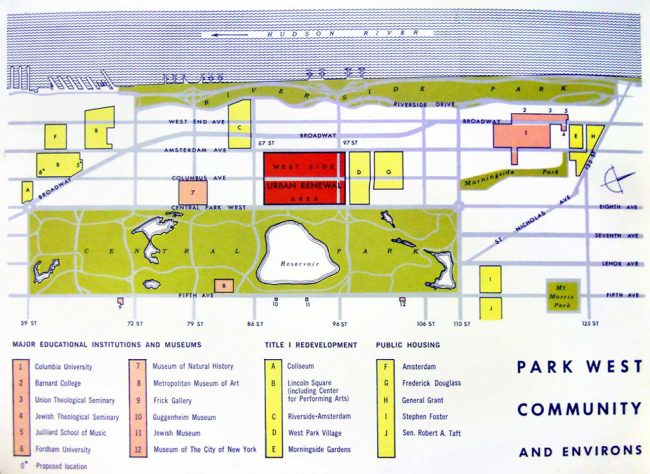
Map of Upper West Side urban renewal and public housing projects from West Side Urban Renewal Area preliminary plan, 1959 | Image via Michael Minn
As planning and implementation of neighborhood rezonings under Mayor de Blasio’s touted housing plan get under way, community-based opposition to urban redevelopment is back in the news, from East New York to the Bronx’s Jerome Avenue. Manhattan’s Upper West Side may seem light years away from these communities — its big news of late ranged from condo conversions to the sale of the naming rights of the New York Philharmonic’s Lincoln Center concert hall for $100 million. But Lincoln Center and large swathes of the Upper West Side are products of 20th century City-driven redevelopment processes that bear more resemblance to Mayor de Blasio’s plans for some outer-borough neighborhoods than one might expect. The Upper West Side’s transition from deindustrialized periphery to well-heeled neighborhood forced questions of neighborhood integration and culture, community and neighborhood rights, and physical and cultural preservation that are equally pertinent today.
Of course, de Blasio’s pending rezonings are quite distinct from urban renewal strategies employed in the mid-20th century. Federal funding for urban renewal and the ability to exercise eminent domain gave the City immense power to reshape neighborhoods as it saw fit. Rezonings, which incentivize or constrict private development through zoning code changes, are much more limited in scope. Mayor de Blasio’s plan centers around upzonings, which allow denser development in neighborhoods. Despite their differences, urban renewal projects and upzonings share the same end goal: to use municipal planning policy to spur private investment in areas with low land values.[1] Housing creation, affordable or otherwise, may be central to their articulation, but it is ultimately secondary to both policies’ overall emphasis on private investment.
Today’s rezonings are part of a long lineage of approaches to neighborhood-scale redevelopment that continues to evolve over time. The physical manifestations and political underpinnings of urban renewal itself changed through the 1950s and 1960s in reaction to grassroots organizing and shifts in the political environment. The story of the redevelopment of the Upper West Side through two particular urban renewal projects — Lincoln Square and the West Side Urban Renewal Area — demonstrates this shift. As community-based groups in East New York and along Jerome Avenue challenge the City’s plans on issues from housing affordability to local business preservation — responding to the failure of Bloomberg-era rezonings to protect neighborhood culture and affordability in neighborhoods like Williamsburg and Greenpoint — this history of the emergence of community rights and preservation in the face of large-scale neighborhood change is worth revisiting.
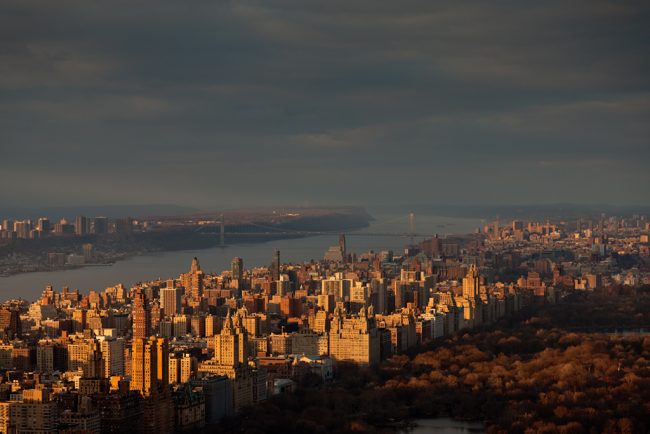
The Upper West Side from Rockefeller Center | Photo via Several Seconds
Redeveloping the “Dismal and Decayed” West Side
Today, Manhattan’s Upper West Side, running from 59th to 110th Street, is associated far more with high-end apartments than the affordable jumble of tenements, rooming houses, and residential hotels that predominated in the neighborhood until the 1970s. Now market-rate real estate includes multi-million dollar brownstones and rentals fetching upwards of $12,000 a month. The main commercial thoroughfares of Broadway and Columbus Avenue are dotted with high-end retailers, their counterparts further concentrated in the luxury mall at Columbus Circle.
In 1939 the area between Broadway and the Hudson River from 59th to 70th Streets was described as a “plebeian district.” New Yorkers knew it as Lincoln Square, a predominately white, working-class neighborhood with a growing Puerto Rican minority that also included San Juan Hill — the city’s largest black community at the turn of the century. An overcrowded home base for maritime, manufacturing, and performing arts workers and their families, Lincoln Square featured housing, commerce, and industry — a mixture of uses that indicated slum conditions to planners and policy-makers of the time. Among progressive housing reformers, the neighborhood was a battleground in the war against disease and crime that officials said spread outward from such districts.
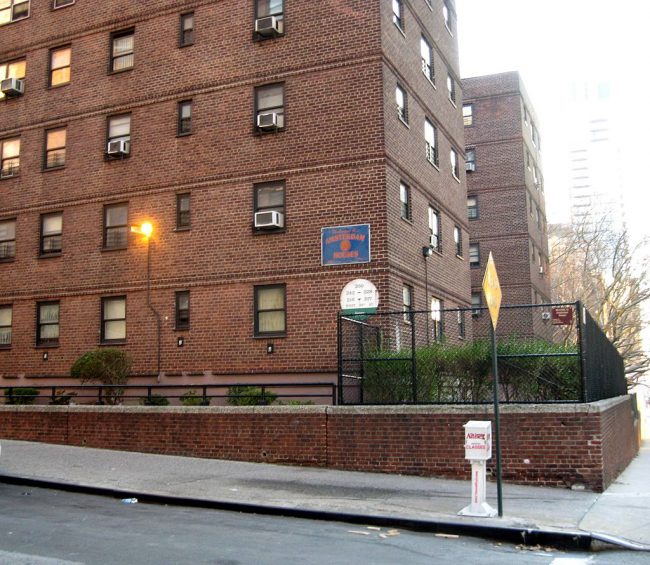
Amsterdam Houses | Photo by Jim Henderson, via Wikimedia Commons
When the 1939 Housing Act ushered in a new era of federal funding for slum clearance and housing redevelopment, the New York City Housing Authority chose San Juan Hill as the future home of the three-block, thirteen-tower Amsterdam Houses. Proposed in 1940, but delayed by the onset of World War II, the project was completed in 1948. All told, the construction of the Houses displaced 1,121 predominately black families, none of whom retained a right to return to the new apartments that replaced them.
But resistance was minimal: mainstream civil rights groups like the NAACP saw the promise of better housing for the city’s black community in NYCHA-driven slum clearance. Even though NYCHA enforced a de-facto neighborhood-based segregationist policy at the time, the new units presented a quality alternative to existing housing options limited by segregation to the most substandard tenement housing in the city.[2] Radical leftist organizations were, however, vocally against NYCHA’s segregationist policy. William Gaulden, an organizer for the National Negro Congress (a communist organization that promoted integration and black liberation), proclaimed, “there must be an end to this vicious system of segregating Negro families in any one part of the city. There is no more room in Harlem for the Negro families living in Lincoln Square.”[3] But rather than arguing for the preservation of San Juan Hill’s existing fabric, the radical leftist push back against slum clearance at this stage focused on broader racial segregation in the city. The Amsterdam Houses went forward.
As part of Lincoln Square was demolished, the rest suffered from redlining. The federal Home Owners’ Loan Corporation had given Lincoln Square west of Broadway a “D” rating, effectively cutting off access to credit for housing investment in the area.[4] The rating accelerated post-war decline already occurring, wrought in part by landlord disinvestment in the cheaply and speculatively built neighborhood. The availability of mortgage financing in the suburbs allowed many white middle- and working-class residents to move out of the physically declining urban core while racist policies barred black and Hispanic tenants from housing options in other parts of the city or suburbs.
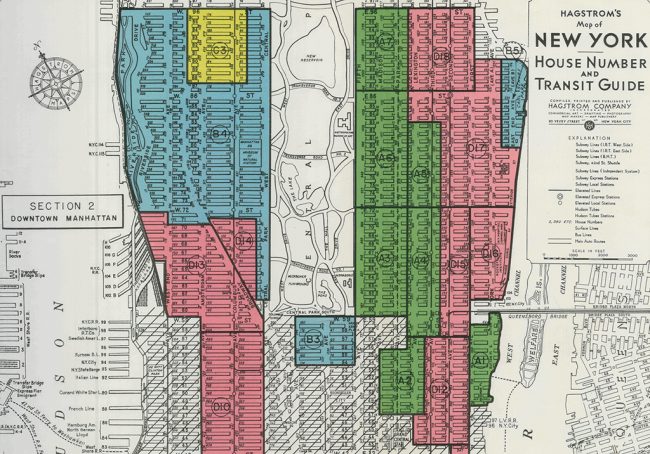
Detail from Home Owners’ Loan Corporation map of Manhattan in 1939 | Image via Urban Oasis
The city’s administrative, business, and union leaders were acutely aware of what deindustrialization and the beginnings of suburbanization were doing to New York, and the aging peripheries of the central business district on the West and East Sides of Manhattan were of particular concern. Lower, non-union wages and fewer regulations, as well as the convenience of interstate truck travel, made the suburbs or international locales more attractive than Manhattan for manufacturing and maritime industries. The deindustrialization process was accelerated by municipal policies that encouraged a shift to FIRE industries — finance, insurance, and real estate — and low-end service jobs and away from manufacturing.
With the passage of the 1949 Housing Act, the city’s leaders gained a new tool for “renewal” in neighborhoods of concern. Unlike the 1939 Housing Act, which stressed the construction of low-income housing through local housing authorities, the 1949 Housing Act opened the door for the construction of middle-income and market-rate housing. The Act also expanded possible slum clearance expenditures from exclusively housing construction to commercial and institutional uses as well. Under Title I of the Act, cities could resell land taken by eminent domain to private developers at below market prices, with the federal government footing the bill for two-thirds of the markdown. The end goal of urban renewal was to transfer the stewardship over the site into private hands quickly, with the chosen project sponsor taking the lead role in all aspects of the redevelopment, from tenant relocation to site planning to construction.
Robert Moses, New York’s “master builder,” exerted control over the City’s capital projects through his positions on the Planning Commission and the Committee on Slum Clearance Projects (CSC), which oversaw the implementation of all federally funded urban renewal (Title I) projects in New York City. By the early 1950s, Moses had begun to envision “a reborn West Side, marching north from Columbus Circle, and eventually spreading over the entire dismal and decayed West Side.”[5]
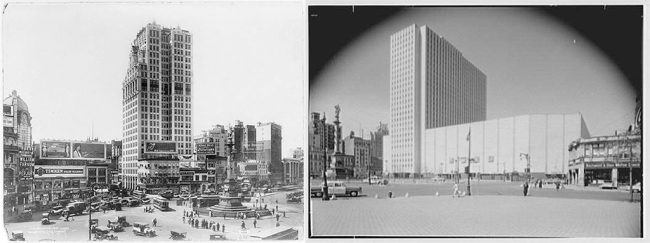
(L) Columbus Circle in 1921, looking west, and (R) New York Coliseum in 1956 | Photos via Library of Congress
Building this new district required multiple projects. It began with Manhattantown, a middle-income housing development in the West 90s. The redevelopment became mired in a corruption scandal as the Tammany-connected project sponsor selected by Moses assumed ownership over still-occupied rental buildings and let them deteriorate while continuing to collect rents. After the sponsor squandered a $2 million loan from the City without actually breaking ground on construction, Moses was forced to find another group of developers to buy out and take over the redevelopment.[6] Manhattantown sounded early warning bells about the pitfalls of urban renewal and Moses’ unaccountable leadership in general.
The redevelopment of Columbus Circle carried Moses’ West Side vision further and showcased the reorientation of urban redevelopment under the 1949 Housing Act: the project revolved around the Coliseum, a convention center, and a 20-story office building included to subsidize the overall project. The Coliseum Park Apartments, two 15-story residential towers, were added to meet federal requirements for Title I funding. From Columbus Circle, Moses announced that “the scythe of progress must move northward,” on to the next project: Lincoln Square.[7]
The 1955 designation of the Lincoln Square Urban Renewal Area served as the capstone for Moses’ reimagining of the Upper West Side and ranked as the largest urban renewal project in the country to date. The project envisioned replacing 18 city blocks of aging tenements, warehouses, small businesses, and light industrial spaces with new homes for the Metropolitan Opera and New York Philharmonic, a new campus for Fordham University, and a luxury housing development. This new remedy to urban blight was a long way from NYCHA’s Amsterdam Houses, completed only seven years prior just around the corner. The last remnants of San Juan Hill and the heart of Lincoln Square, along with approximately 7,000 families, were replaced with a marble monument to high culture that Jane Jacobs scathingly described as “planned entirely on the assumption that the logical neighbor of a hall is another hall. Nonsense. … It is a piece of built-in rigor mortis.”[8]
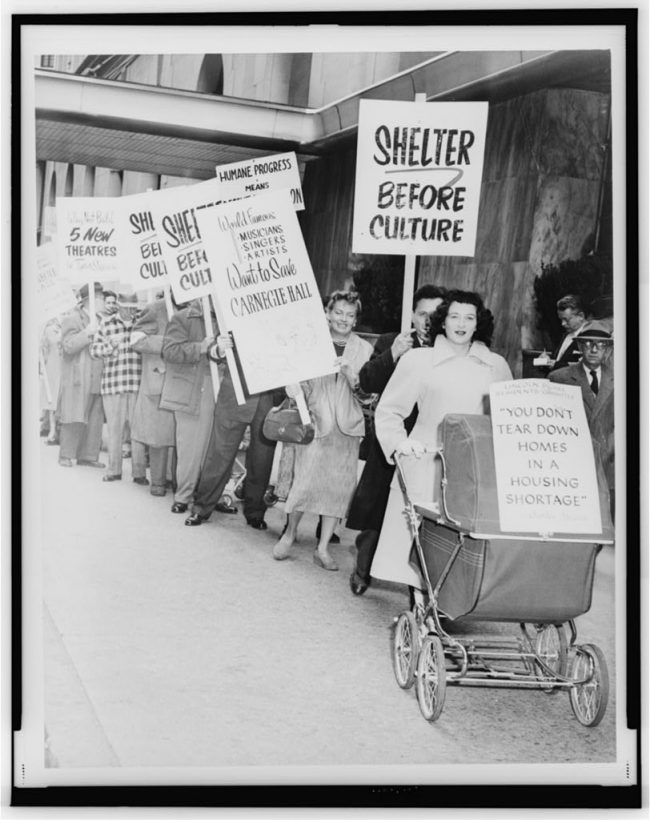
Ellan Levitt leads picket line protesting proposed destruction of Lincoln Square neighborhood to build Lincoln Center. | Photo by Phil Stanziola, via Library of Congress
Local residents picketed City Hall and Moses’ public appearances while challenging the use of eminent domain in the courts. Stopping the project — pronounced as crucial to the city’s future by the project’s elite backers — proved impossible. Urban renewal in Lincoln Square was also a pawn in the Cold War, the new Lincoln Center a milestone in the cultural struggle against communism. The complex was regarded as a sibling to the United Nations — a contribution to a better society and an embodiment of American cultural preeminence to complement the country’s seat at the helm of worldwide diplomacy, just across town on the East River. President Eisenhower even broke ground on the project in 1959, calling it “a mighty influence for peace and understanding throughout the world.”[9]
These global politics meant little to the displaced residents who began to challenge the relationship between slum clearance and supposed urban renewal with the concept of community rights — that the residents’ moral claim to their neighborhood and culture built around physical connections to homes, businesses, and streets overrides expert-driven opinion of what constitutes the best use for urban land.[10] Despite the City’s stated intention to democratize high culture with the project, the construction of a marble palace catering to the gentry on top of the rubble of tenements made the project a natural target for resistance.
Rather than renew, the Lincoln Center Urban Renewal Area remade. In The Case Against Lincoln Center, Third World Newsreel juxtaposes the plaza of the newly built Lincoln Center with the street life it replaced — volleyball games in the street and card games on the stoop, underscored by Puerto Rican drum rhythms and accordion-punctuated ballads performed in the open air. Built with cars in mind, Lincoln Center’s original incarnation was difficult to approach by foot. The uninviting central plaza, designed to discourage loitering, was flanked by buildings that turned away from the street. But by pouring an unprecedented amount of federal money into the neighborhood, the $150 million urban renewal project did achieve its primary goal: to kick-start private redevelopment in the surrounding blocks and create a monumental home for some of the most revered cultural groups in the city. Some critics also derided the cultural model Lincoln Center represented: the concentration of arts institutions into one campus and a perceived catering to the upper classes. Lincoln Center did, however, take steps to serve a broader audience. From 1966 to 2010, it was the home to the New York City Opera, founded by Fiorello LaGuardia with the goal of making high culture accessible to the masses. The Lincoln Center Out of Doors Festival, begun in 1970 and continuing to this day, “served as the first major formal performance venue for hip hop, featuring a competition for breakdances in August 1981.”[11]
Urban Renewal Amid Urban Crisis
While Lincoln Center was under construction, the tide against the bulldozer approach of modernist urban redevelopment turned. Robert Moses’ brash approach to tenant relocation, egregious conditions in tenements slated for demolition, and the CSC’s practice of awarding contracts to Tammany Hall-backed sponsors had finally caused alarm among left-leaning groups and politicians, the same reformers who had previously championed slum clearance. As the number of designated slums grew, so did the number of displaced tenants, and organizing against displacement formalized into a loose citywide coalition. In 1958, Mayor Wagner — responding to this criticism and new federal mandates under the 1954 Housing Act — created an Urban Renewal Board (URB) in the Department of City Planning.[12] In 1960, Wagner transferred responsibility for all future urban renewal projects away from the CSC; Moses was forced to resign that same year and the CSC shuttered soon after.[13] URB Chairman James Felt, instead of ending urban renewal or fully breaking with Moses’ legacy, modified its definition.
A URB study of the Upper West Side released in 1958 stated that urban renewal should be “like pruning a tree, resulting in a healthier and more fruitful organism.”[14] Felt’s approach stressed transparency, neighborhood engagement, and the preservation and renovation of a large portion of brownstones in the area. The study incorporated language about comprehensive planning and neighborhood “self-healing,” echoing staunch urban renewal opponent Jane Jacobs.[15] The West Side Urban Renewal Area (WSURA) — adopted in 1962 and running from 86th to 97th Street between Amsterdam and Central Park West — became a test case for this more sensitive approach to urban redevelopment.
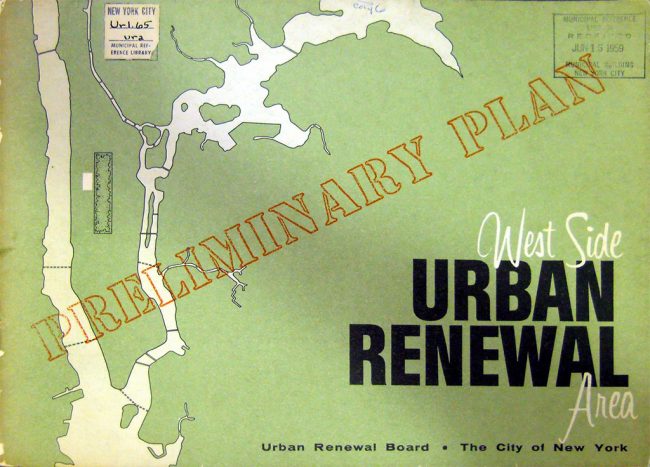
Cover of preliminary plan for West Side Urban Renewal Area | Image via Michael Minn
Despite the changes, the City did not cede control over any stages in the planning process to neighborhood groups. At first, it provided funding to the Stryckers Bay Neighborhood Council and Goddard-Riverside to conduct resident engagement in the neighborhood, but soon decided to establish its own community affairs section.[16] Both groups would join other activists pushing for more affordable housing and programs targeting existing neighborhood residents from outside the City’s process.
WSURA’s measured method, in addition to the City’s mounting financial issues, slowed the plan’s implementation. In 1968, 36 of the area’s brownstones were preserved as NYCHA’s still-existing WSURA Brownstones cluster. Further breaking with urban renewal orthodoxy, the City used property tax breaks and below-market mortgages to sell the majority of the area’s renovated brownstones to individual purchasers through the 1970s, including “pioneering” middle-class families attracted to the en vogue building type in low-income neighborhoods across the city — an “urban discovery narrative” still repeated in the city’s newly gentrifying neighborhoods.
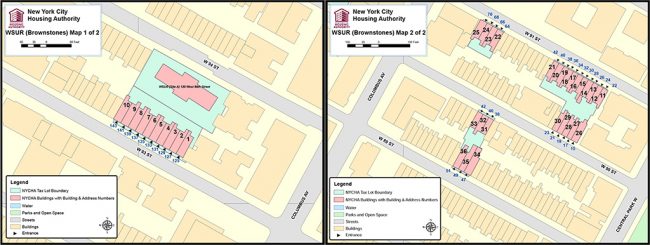
Maps of NYCHA’s WSURA brownstone clusters | Images via NYCHA
The Urban Renewal Board did not, however, fully abandon demolition and high-density construction within WSURA. The City planned for a mix of towers — market rate, middle-income Mitchell-Lama, and public housing — along Columbus and Amsterdam Avenues and used eminent domain to demolish tenements and single room occupancy (SRO) hotels in their way. Towers built in WSURA do, however, align with the existing grid, and the plan did not carve out whole blocks like Lincoln Center or Manhattantown.
The slate of the neighborhood wasn’t wiped fully clean, but these demolitions and the transformation of rooming houses to standard apartments continued urban renewal’s mass displacement. The majority of WSURA’s privately-owned low-rent housing units — accessible to low-income families, seniors living on fixed incomes, and individuals with substance abuse issues and mental disabilities — were erased. SRO hotels in particular, though frequently overcrowded and not up to code, filled a specific need in the housing market, and supportive housing groups formed to partially fill the gap left by their removal. Title I did not provide any kind of operational subsidy for housing affordability (unless paired with another program), ensuring the production of higher-end housing (middle-income or luxury, depending on market costs) beyond the reach of those who lived in the neighborhood. As land values and rents rose, political will and financing for affordable housing began to wither in the 1970s. Affordability in the neighborhood went the way of the SROs, even as some of the buildings that once housed them were preserved. Stryckers Bay Neighborhood Council estimated that the project reduced the neighborhood’s low-income population from 60 to 17 percent.[17]
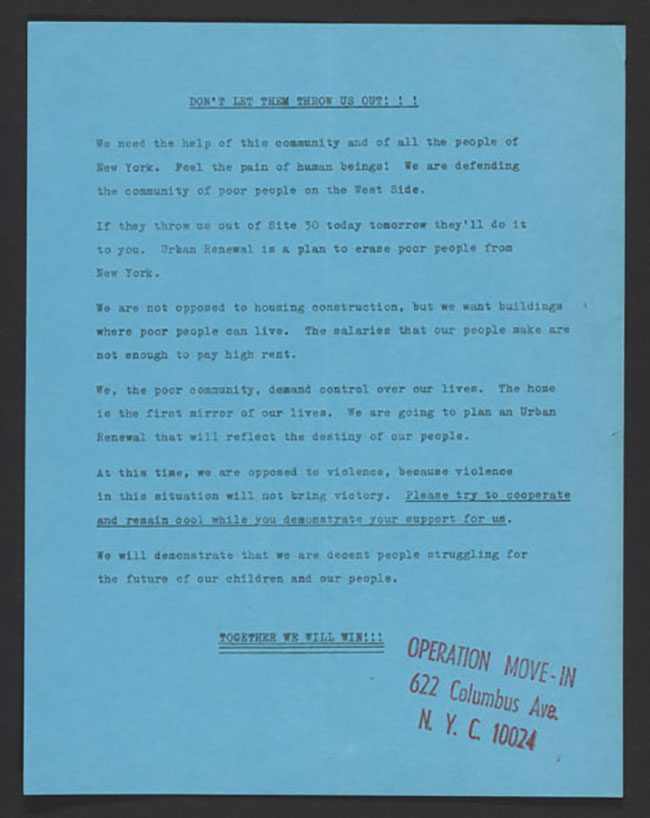
Operation Move-In flyer | Image via Metropolitan Council on Housing
A new wave of radical actions by tenant activists surrounded WSURA’s implementation. In “Operation Move-In,” one of the largest coordinated squatting actions in city history, activists broke into nine buildings slated for demolition around Columbus Avenue and West 80th Street in the summer of 1970 and soon took over other buildings pending private redevelopment in Morningside Heights. Squatters’ claims to City-owned apartments were an outgrowth of the notion of community rights advanced by displaced tenants in Lincoln Square: that residents had the right to stay and were more capable than either the City or private developers to identify the best use for the now-vacant units.
While squatters took up residence in the urban renewal area, the City sunk deeper into a fiscal crisis. Even the City’s sensitive approach to urban renewal seemed out of touch given its mounting issues. Soon after, the federal government implemented the Housing and Community Development Act of 1974, signaling an end to public housing construction and Title I urban renewal. The State’s Mitchell-Lama program, underwritten by bond issues, also came to an end in 1974. The WSURA plan was never fully implemented, and only a third of the 6,700 low- and middle-income housing units promised in the initial plan were actually built.
The era of direct federal and state subsidies for urban redevelopment projects, implemented across the country, was effectively over. Signifying a shift in the City’s approach to incentivizing development, the last few residential towers planned for WSURA were completed using tax subsidies in the late 1980s.
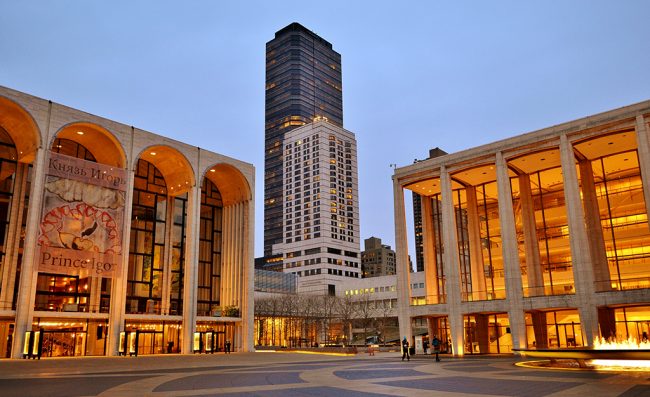
Lincoln Center, looking southwest| Photo via Gigi NYC
A Renewed West Side
The different approaches, and results, of the Lincoln Square and West Side Urban Renewal Areas are still visible on the Upper West Side. Lincoln Center, the pinnacle of modernist urban renewal, physically obliterated the existing neighborhood. WSURA preserved some built vestiges of the previous neighborhood but still transformed the neighborhood’s culture by displacing existing residents, who saw little benefit from the redevelopment. The end result of both urban renewal plans were new neighborhoods; it is almost impossible to imagine the Upper West Side, and these two areas, as the diverse, working-class communities that existed just 40 years ago.
Key differences in the results, however, remain. WSURA’s implementation coincided with the development of non-profit supportive and affordable housing organizations, like the West Side Federation for Senior and Supportive Housing, which preserved affordability in the neighborhood through the 1980s. A very small number of apartments occupied by the Operation Move-In squatters turned into low-income cooperatives through the City’s Tenant Interim Lease Program. The focus on physical preservation of buildings in WSURA resulted in the preservation of rent-regulated buildings that still stand in contrast to the area’s perceived luxury.
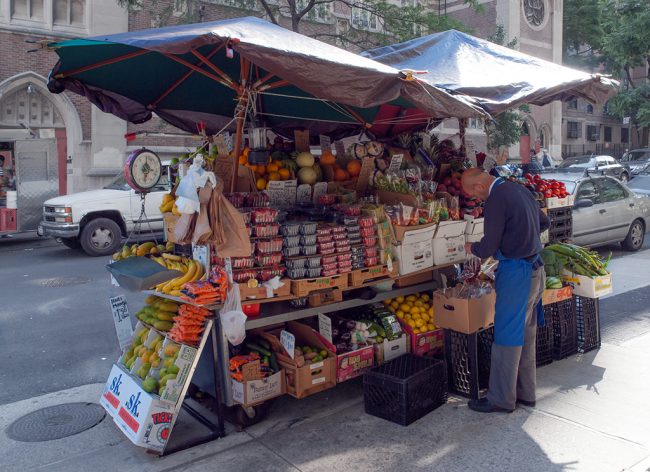
Fruit Vendor on 93rd Street | Photo via Franco Folini
In its reorientation toward preservation of form and, to lesser extent, function, WSURA allowed for the development of a unique retail landscape of local restaurants, antique stores, boutiques, and the supermarkets, florists, locksmiths, and hardware stores that remain in parts of the Upper West Side despite skyrocketing commercial rents. Such businesses are noticeably absent from Lincoln Square and Columbus Circle, where storefronts are increasingly filled with the likes of Banana Republic, Coach, Apple, and seemingly ubiquitous bank branches, described by one writer as a new urban blight. By wiping the neighborhood slate clean and encouraging the rapid increase of property values, Lincoln Square laid the groundwork for a commercial landscape where small local businesses could not compete. In WSURA small businesses that weathered urban renewal or established themselves in the area during the redevelopment, before commercial rents went through the roof, could at least try to hold out. While the Upper West Side continues to be a neighborhood that caters to its own residents, the pocket of Lincoln Square feels fully oriented toward visitors.
While most urban renewal programs across the United States were eliminated when federal funding ran dry, it was never fully abandoned in New York. The city continued to adopt urban renewal plans after 1974 and to implement pre-1974 plans. Today the Seward Park (adopted in 1952), Broadway Triangle (1965), and Arverne (1968) urban renewal areas are still actively being redeveloped, and another generation of organizers is trying to shape the process to fit their neighborhoods’ needs.
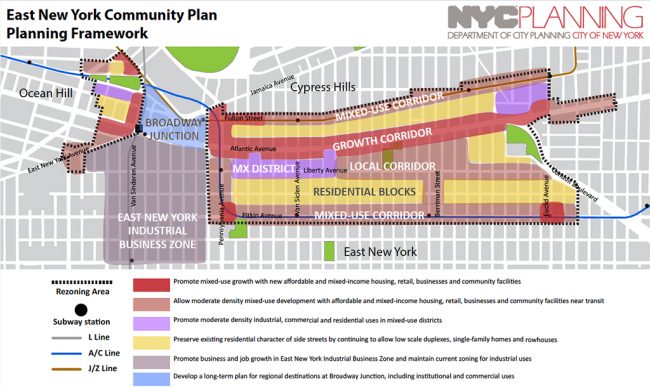
NYC Department of City Planning East New York rezoning plan, 2015 | Image via NYC DCP
At the same time, new housing policies rooted in neighborhood upzonings are a form of urban redevelopment in succession to urban renewal, a different mechanism that, for better or worse, maintains the City’s interest in raising land values. They may not involve the City taking possession of land and demolishing blocks, but the land value they generate and private capital they attract can dramatically change a neighborhood’s composition. The wariness of residents in neighborhoods slated for upzonings today is understandable given the City’s long history of development-driven displacement. City-incentivized development has often stood in direct opposition to the community rights argument developed in the late 1950s: that existing residents not only have the right to stay in their renewed neighborhood, but to play a central role in shaping the redevelopment process.
As the de Blasio administration’s new round of rezonings get underway, the case studies of Lincoln Square and WSURA should illustrate to activists that these processes are up for negotiation. Neighborhood residents can and should play a role in deciding what their neighborhood will look like in the near future. For the City, the legacy of urban renewal and past upzonings calls for a further evolution of urban redevelopment, one that honestly integrates the preservation of existing communities into plans for truly renewed, not remade, neighborhoods.
NOTES:
[1] While zoning code changes that constrict development can also generate land values (for example, by adding value to a particular architectural style), their relationship to urban renewal is much more limited.
[2] Bloom, N. D., Public Housing That Worked: New York in the Twentieth Century (2009), 87.
[3] “Tenants seek rehousing aid: Lincoln Square group discusses topic at gathering,” New York Amsterdam News (December 7, 1940).
[4] Zipp, S., Manhattan Projects: The Rise and Fall of Urban Renewal in Cold War New York (2012), 219.
[5] Zipp, 169.
[6] Pritchett, W. E., Robert Clifton Weaver and the American City: The Life and Times of an Urban Reformer (2008), 200.
[7] Flint, A., Wrestling with Moses: How Jane Jacobs Took On New York’s Master Builder and Transformed the American City (2009), 106.
[8] Foulkes, J., “Streets and stages: Urban renewal and the arts after World War II,” Journal of Social History (2010), 417.
[9] “President turns earth to start Lincoln Center,” New York Times (May 15, 1959).
[10] Gold, R., When Tenants Claimed the City: The Struggle for Citizenship in New York City (2014) and Zipp, 428.
[11] Foulkes, 416.
[12] Reaven, M., Citizen Participation in City Planning: New York City, 1945-1975 (2009) (PhD dissertation), 158.
[13] Reaven, 158.
[14] Rowan, C.E., “The New York School of Urban Ecology: The New Yorker, Rachel Carson, and Jane Jacobs,” American Literature (2010), 598
[15] Ballon, H., “Robert Moses and Urban Renewal: The Title 1 Program,” in Robert Moses and the Modern City (2008), 113.
[16] Reaven, 170.
[17] Fainstein, N.I. & Fainstein, S.S., “Governing Regimes and the Political Economy of Development in New York City, 1946-1984,” in Power, Culture, Place: Essays on New York (1988), 188.
The views expressed here are those of the authors only and do not reflect the position of The Architectural League of New York.
Comments